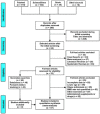The Effect of Resistance Training on Bone Mineral Density in Older Adults: A Systematic Review and Meta-Analysis
- PMID: 35742181
- PMCID: PMC9222380
- DOI: 10.3390/healthcare10061129
The Effect of Resistance Training on Bone Mineral Density in Older Adults: A Systematic Review and Meta-Analysis
Abstract
Resistance training (RT) has been considered an intervention with effective stimulus on bone mineral formation and is, therefore, recommended to decrease the rate of bone morpho-functional proprieties loss with aging. Thus, this meta-analysis aimed to analyze the effectiveness of RT protocols in promoting changes in bone mineral density (BMD) in older adults. The systematic reviews and meta-analysis followed the PRISMA guidelines (PROSPERO CRD42020170859). The searches were performed in the electronic databases using descriptors according to the PICO strategy. The methodological quality and risk of bias were assessed with the PEDro scale, and the magnitude of the results was determined by Hedges' g. Seven studies involving 370 elderlies, with the RT planned as a unique exercise mode of intervention, showed designs with four to five exercises for upper- and lower-limbs musculature, two to three sets per exercise, eight to twelve repetitions to failure at 70-90% 1 RM, 60-120 s of rest between sets, and executed three times per week for 12-52 weeks. The RT protocols were classified between good and excellent and evidenced a positive effect on the BMD at the hip (0.64%) and spine (0.62%) but not in the femoral neck (-0.22%) regardless of the intervention length. The narrow range of either positive or negative changes in the BMD after the RT intervention support, at best, a preventive effect against the increasing risk of bone frailty in an older population, which is evident beyond 12 weeks of RT practice engagement.
Keywords: aging; bone mineral content; strength training.
Conflict of interest statement
The authors declare no conflict of interest.
Figures



References
-
- Cadore E.L., Brentano M.A., Kruel L.F.M. Efeitos da atividade física na densidade mineral óssea e na remodelação do tecido ósseo. Rev. Bras. Med. Esporte. 2005;11:373–379. doi: 10.1590/S1517-86922005000600013. - DOI
-
- Guimaraes B.R., Pimenta L.D., Massini D.A., Dos Santos D., Siqueira L., Simionato A.R., Dos Santos L.G.A., Neiva C.M., Pessôa Filho D.M. Muscle strength and regional lean body mass influence on mineral bone health in young male adults. PLoS ONE. 2018;13:e0191769. doi: 10.1371/journal.pone.0191769. - DOI - PMC - PubMed
-
- Pimenta L.D., Massini D.A., Dos Santos D., Siqueira L.O.C., Sancassani A., Dos Santos L.G.A., Guimarães B.R., Neiva C.M., Pessôa Filho D.M. Women’s femoral mass content correlates to muscle strength independently of lean body mass. Rev. Bras. Med. Esporte. 2019;25:485–489. doi: 10.1590/1517-869220192506208956. - DOI
Publication types
Grants and funding
- 2016/04544-3/São Paulo Research Foundation
- 001/Coordenação de Aperfeicoamento de Pessoal de Nível Superior
- 88887.310463/2018-00/Coordenação de Aperfeicoamento de Pessoal de Nível Superior
- 88887.572557/2020-00/Coordenação de Aperfeicoamento de Pessoal de Nível Superior
- UIDB/04748/2020/Fundação para a Ciência e Tecnologia
LinkOut - more resources
Full Text Sources

